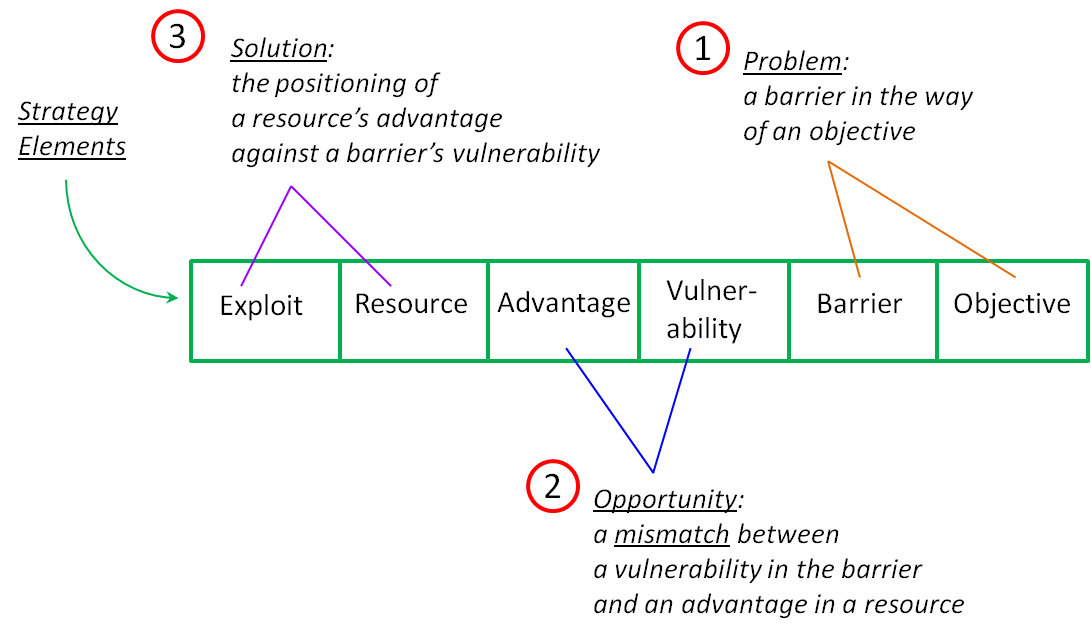Gotta’ have Anatomy
Look at the guys in the Rembrandt painting. They’re old doctors getting an anatomy lesson from the one wearing a hat. Troubling. How can you have been a doctor unless you understood the parts of the body and how they work together? But here these puzzled-looking doctors are, finally getting an anatomy lesson.
Reminds me of where we are with strategy today. We need a small dose of strategy anatomy.
It was quite a lag in time before the Western medical profession adopted what should be considered the most minimal understanding necessary to be a practicing doctor. But in many fields a long lag in general understanding, together with the skills based on that understanding, isn’t so unusual.
Take geometry. For a very long time the ancient Egyptians had one geometry for re-surveying the land after the annual inundation from the Nile, another geometry they used for building pyramids and other large structures, and another one for navigation. Each of these had its own concepts, formulas, rules of thumb, etc. Eventually Pythagoras, Euclid and others said (in effect) “Wait a minute, geometry is geometry. Here are the basic concepts, here are the basic relationships. Once you understand them you can apply them to all situations.”
Where are we with strategy today? In the Ancient Egypt Phase. Strategy as a subject has remained fragmented into parochial specializations.
Here’s a fun exercise that confirms my point. Walk into any public library. Ask to be directed to the strategy section. After a moment of confusion, the librarian will tell you that there isn’t a strategy section – but that they do have a lot of books on strategy in a lot of different sections. “Were you looking for one on business strategy, or military history, or football strategy? Or perhaps investment strategy or video game strategy, or – what? I’m sure we could find it for you.”
Case closed. Try it. You’ll see.
But just as geometry is geometry, strategy is strategy. We want to be able to apply our basic understanding and skills to any problem requiring a strategy; not limited to some specific field. And like the 17th century Dutch doctors in the picture, we need to start with a basic understanding of anatomy. In our case of course, the anatomy of a strategy.
Fortunately, the anatomy of a strategy is really simple compared with the anatomy
of the human body. But it’s still an anatomy and we still need to understand it.
First the elements
Let’s work from the bottom, up. The lowest-level pieces of a strategy are the 6 elements identified in the previous post. [Why these 6 elements? Why not 5 or 7? Why these 6; why not different ones? Fair questions. I’ll get back to it in another post. Meanwhile, please accept the 6 as a “working” set while we move forward].
Let’s get a handle on them by talking about just what they are, and what their roles are in a strategy. After that, we’ll look at how they naturally combine.
- Objective: the desired result of a strategy. Role: the intention that creates pull during the mental process of devising a strategy. Ultimately, however you come up with a strategy, all of the other elements form around this one. If you’re like me, it’s often the case that you don’t know exactly what you want when you start out. You probably have a rough idea. That rough idea is your working objective. If the other pieces don’t come together to support it, shift what you want until you get what you need (The Rolling Stones were right).
- Barrier: an impediment to achieving an objective. Role: it provides the reason we even need a strategy! No barrier, no problem. The objective is in hand. But given a barrier, we have to think our way past it. A barrier is a way in which reality makes itself known to us. And the strategy we devise is our vehicle for dealing with the reality our barrier has shown us.
- Vulnerability: a weakness in a barrier. Role: a potential opening to exploit in devising a strategy. It is inextricably related to the Advantage, which we discuss next:
- Advantage: favorable leverage in available resources. Role: something that can be brought to bear on a vulnerability in a barrier. Here’s where it gets interesting. Notice that if there’s no vulnerability, there’s no meaningful advantage, and if there’s no advantage, then there’s no vulnerability. For every advantage, there is an equal and opposite vulnerability. Advantage and vulnerability are two sides of the same coin. They’re indivisible and exist only relative to each other. They’re the same thing – but as looked at from either the direction of the barrier or from the direction of available resources. The best term I have for this “coin” is mismatch. More about this idea in the next post.
- Resource: source of available advantages. Role: enabler of strategies. You’ve got to have the means. When we say someone is resourceful, we’re saying they’re good at recognizing resources in their environment and at finding advantages in those resources. Odysseus. McGyver. The resource may be ready to use or it may be convertible. Example: in your cupboard, you may already have the ingredients you need for a stew. No conversion of those resources needed. Otherwise, you’ll have to go to the supermarket and convert some of the cash resources in your wallet into the groceries you need. The need to convert resources often spawns sub-strategies, increasing complexity inside our strategies.
- Exploit: how an advantage is employed against a vulnerability to get past a barrier. Role: it pulls the elements together into a specific strategy. “It ain’t what’cha do, it’s the way what’cha do it, and that’s what gets results”, as Ella Fitzgerald says. If for example two enemy forces are facing one another, there are two immediate concerns: 1) the Order of Battle (arms of all kinds, troops, etc. – and their capabilities) available to the enemy (vs. one’s own – this shows advantages and vulnerabilities), and 2) the Disposition of Forces (how those enemy assets are and can be arrayed, vs. one’s own – positional advantages and vulnerabilities). Knowledge of the Order of Battle and Disposition of Forces is the very knowledge of present and possible vulnerabilities and advantages, out of which generals and their staffs can fashion their strategy to meet the objective of winning the battle. Obviously some ways of employing one’s advantages are going to be more effective than others. The Exploit is the final choice of how the advantages are to be employed against vulnerabilities.
Element pairs
With the elements now in hand, we can see that they pair up in a very simple and natural way, resulting in 3 pairs that reflect how we normally think: problem > opportunity> solution. The diagram below represents the elements of a strategy and how they work together. A.k.a. anatomy of a strategy.
Pairing the elements this way is very cool, because it makes it really easy to think about strategies.
_______________________
Readers are encouraged to add comments to this post.
And if you’d like to share or recommend the post, click on your preferred way in the left margin sidebar.
In the next post we’ll look closer at one of the pairs: mismatch – the pivotal point and heart of a strategy.
If you’re not currently being automatically notified when new posts are published, then please Follow Real Strategy (top of right hand column on this page), and indicate how you’d prefer to be notified.
For other posts of interest, look in the Smart Menu.
Photo credit: Anatomy Lesson of Dr. Nicolaes Tulp, Wikipedia, http://en.wikipedia.org/wiki/Rembrandt








nice summary of the universal process of problem solving. Hope the Broncos have the resources to exploit the Patriots vulnerabilities to overcome the barrier to achieving the objective!
[Translate]
Bill,
Jeff Beaton and I were talking about your six elements yesterday. One of the things I would like to discuss is the effect of corporate silo’s on strategy. My belief is that companies should connect silo’s instead of forcing the customer to do it.
[Translate]
Thanks for the comments, guys.
Jim – too bad about the Broncos, but they were facing Belichick, in my opinion the NFL Master Strategist of our time.
Bob – Amen to not making it the customer’s job to get the silos together. In the next post we’ll start talking about devising strategies, and in the one after that, devising complex strategies. And that’s where sub-strategies come in. In the strategy of a business, the strategy of each silo should be a sub-strategy of the overall strategy. If the silos aren’t on the same page it means they aren’t supporting the overall bus. strategy. Bad for the business; bad for the customer. A way of connecting the silos and obviating the problem is to have them share elements of the overall strategy. I appreciate the comment and look forward to more discussion …
[Translate]
I’m only familiar with grain silos. Are we talking corn or wheat here?
[Translate]
“Silo” is an interesting term in this context. Regrettable that they are often run as fiefdoms. Better to have each silo invested in the overall strategy.
[Translate]